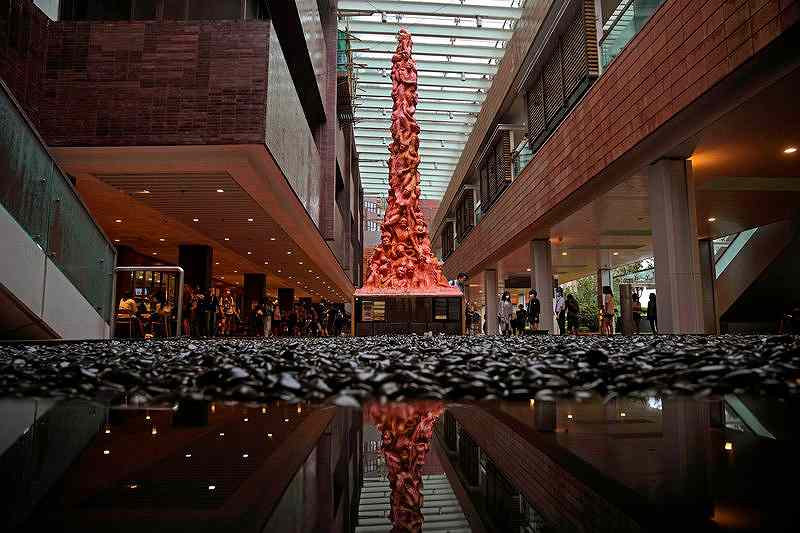
The “Pillar of Shame” statue, a memorial for those killed in the 1989 Tiananmen crackdown, is displayed at the University of Hong Kong, Oct. 13.
16:44 JST, December 23, 2021
HONG KONG (AP) — A monument at a Hong Kong university that commemorates the 1989 Tiananmen Square massacre was removed by workers early Thursday over the objections of its creator from Denmark.
The 8-meter tall Pillar of Shame, which depicts 50 torn and twisted bodies piled on top of each other, was made by Danish sculptor Jens Galschiøt to symbolize the lives lost during the bloody military crackdown on pro-democracy protesters in Beijing’s Tiananmen Square on June 4, 1989.
Workers barricaded the monument at the University of Hong Kong late Wednesday night. Drilling sounds and loud clanging could be heard coming from the boarded-up site, which was patrolled by guards.
The dismantling of the sculpture came days after pro-Beijing candidates scored a landslide victory in the Hong Kong legislative elections, after amendments in election laws allowed the vetting of all candidates to ensure that they are “patriots” loyal to Beijing.
The removal also happened in the same week that Hong Kong leader Carrie Lam traveled to Beijing to report on developments in the semi-autonomous Chinese city, where authorities have silenced dissent following the implementation of a sweeping national security law that appeared to target much of the pro-democracy movement following mass protests in 2019.
The Pillar of Shame monument became an issue in October, with the university demanding that it be removed, even as activists and rights groups protested. Galschiøt offered to take it back to Denmark provided he was given legal immunity that he won’t be persecuted under Hong Kong’s national security law, but has not succeeded so far.
“No party has ever obtained any approval from the university to display the statue on campus, and the university has the right to take appropriate actions to handle it at any time,” the university said in a statement Thursday.
“Latest legal advice given to the university cautioned that the continued display of the statue would pose legal risks to the university based on the Crimes Ordinance enacted under the Hong Kong colonial government.”
The university said that it had requested for the statue to be put in storage and would continue to seek legal advice on follow-up actions.
In October, the university informed the now-defunct candlelight vigil organizer, the Hong Kong Alliance in Support of Patriotic Democratic Movements of China, that it had to remove the statue following “the latest risk assessment and legal advice.”
The organization had said that it was dissolving, citing a climate of oppression, and that it did not own the sculpture. The university was told to speak to its creator instead.
When reached by The Associated Press, sculptor Galschiøt said he was only aware of what was happening to the sculpture Wednesday from social media and other reports.
“We don’t know exactly what happened, but I fear they destroy it,” he said. “This is my sculpture, and it is my property.”
Galschiøt said that he would sue the university if necessary to protect the sculpture.
He had previously written to the university to assert his ownership of the monument, although his requests had gone largely ignored.
Over 100 pro-democracy activists have been arrested since Beijing implemented the national security law in Hong Kong. It outlaws secession, subversion, terrorism and foreign collusion to intervene in the city’s affairs. Critics say it rolled back freedoms promised to Hong Kong when it was handed over to China by Britain in 1997.
The Pillar of Shame monument has been erected for over two decades, and initially stood at Hong Kong’s Victoria Park before eventually being moved to the University of Hong Kong on a long-term basis.
Each year on June 4, members of the now-defunct student union would wash the statue to commemorate the Tiananmen massacre. The city, together with Macao, were previously the only places on Chinese soil where commemoration of the Tiananmen crackdown was allowed.
Over the past two years, the annual candlelight vigil in Hong Kong had been banned by authorities, who cited public risks from the coronavirus pandemic.
Some 24 activists were charged for their roles in the Tiananmen vigil last year, during which activists turned up and thousands followed, breaking past barricades in the park to sing songs and light candles despite the police ban on the event.
"News Services" POPULAR ARTICLE
-

American Playwright Jeremy O. Harris Arrested in Japan on Alleged Drug Smuggling
-

Japan’s Nikkei Stock Average as JGB Yields, Yen Rise on Rate-Hike Bets
-

Japan’s Nikkei Stock Average Licks Wounds after Selloff Sparked by BOJ Hike Bets (UPDATE 1)
-

Japanese Bond Yields Zoom, Stocks Slide as Rate Hike Looms
-

Japan’s Nikkei Stock Average Buoyed by Stable Yen; SoftBank’s Slide Caps Gains (UPDATE 1)
JN ACCESS RANKING
-

Keidanren Chairman Yoshinobu Tsutsui Visits Kashiwazaki-Kariwa Nuclear Power Plant; Inspects New Emergency Safety System
-

Imports of Rare Earths from China Facing Delays, May Be Caused by Deterioration of Japan-China Relations
-

University of Tokyo Professor Discusses Japanese Economic Security in Interview Ahead of Forum
-

Japan Pulls out of Vietnam Nuclear Project, Complicating Hanoi’s Power Plans
-

Govt Aims to Expand NISA Program Lineup, Abolish Age Restriction

























